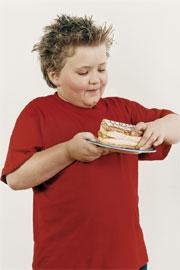 When you eat a cake, do you get the same calories out of it as everyone else?© Punchstock
When you eat a cake, do you get the same calories out of it as everyone else?© PunchstockScientists have identified a key microbe in our guts that helps us glean more calories from food. The discovery backs the idea that the type of microbes in our gut help to determine how much weight we gain, and that seeding the intestine with particular bugs could help fight obesity.
Our intestines are teeming with bacteria and other microorganisms that help to digest the food we eat. But scientists are only just beginning to tease out what each microbe does amidst the swarming life in these dank, dark tubes.
Buck Samuel of Washington University in St Louis, Missouri, and his colleagues focused on one microbe called Methanobrevibacter smithii, which is effectively a waste-removal bug. It eats up the hydrogen and waste products released by other microbes, and converts them into the methane that escapes from our rear ends everyday. "It's a minor component of the gut flora with a major impact," Samuel says tactfully.
M. smithii may have a dirty job, but Samuel and his colleagues have now shown that it is a vital one. They found that by clearing waste products it helps other gut bacteria digest some of the fibrous components of food that we cannot, and turn them into material that our bodies can use. Without these bugs, waste accumulates and blocks the activity of other gut bacteria.
The researchers found that mice with a hefty dose of M. smithii in their guts are fatter than those that don't have the bacteria.
Calorie counting
The discovery suggests that calorie counts on food labels could be misleading, because different people may glean a different number of calories from an identical banana or cheeseburger, based on the individual mix of microbes in their gut.
 Helen Pearson is at the ASM conference in Orlando. Read her diary reports reports/americansocietyofmicrobiology/">here.
Helen Pearson is at the ASM conference in Orlando. Read her diary reports reports/americansocietyofmicrobiology/">here.Up to 85% of people harbour M. smithii or its cousins in their gut. Samuel's team is now interested in examining whether overweight people have more of this kind of bacteria, or underweight people less.
If their theory holds up in people, then it might be possible to gain or shed pounds by planting different microbes in our guts. At this stage, though, that is "total speculation" says Samuel.
Samuel presented the results at the American Society for Microbiology meeting in Orlando, and will publish them shortly in the Proceedings of the National Academy of Sciences.
Fatty acids
The researchers took mice that had been grown in a sterile environment, with no microbes in their guts, and injected them with a very common strain of human intestinal bacteria, called Bacteroides thetaiotaomicron. Some of the mice also received a dose of of M. smithii.
About 100 times more microorganisms took up residence in the colon of mice injected with both B. theta and M. smithii than in those injected with B. theta alone. This suggests that the presence of waste-removing M. smithii was somehow helping other bacteria to thrive. "There's something cool going on," Samuel says.
ADVERTISEMENT
When both microbes were present, B. theta boosted the activity of genes involved in breaking down and metabolizing fructans — a food component common in onions, wheat and asparagus that the human gut cannot digest by itself. B. theta converted the fructans into fatty acids, some of which were taken up by the mouse gut and either used as fuel or stored as fat.
In humans, around 10% of our calories come from such microbe-manufactured fatty acids.
After a few weeks, mice with both types of microbe had approximately 40% more of a particular fatty acid called acetate in their blood, and carried 15% more fat.
Visit our bugmakesfoodyield_m.html">newsblog to read and post comments about this story.
